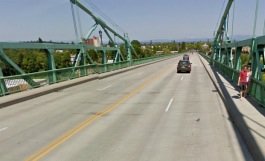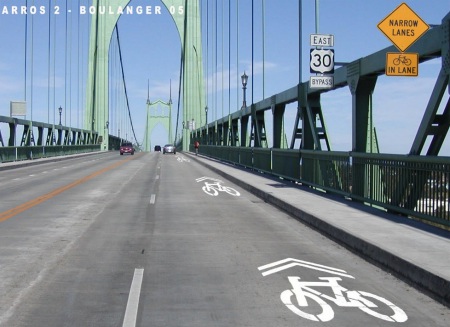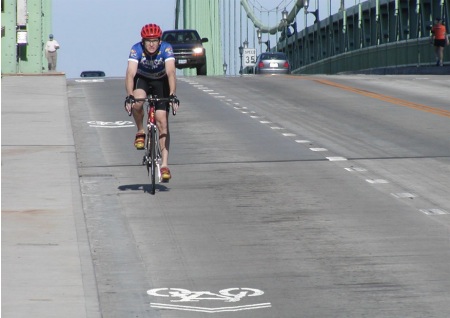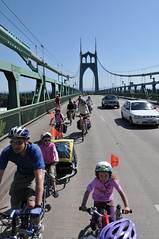
(Google streetview)
ODOT Region 1 Manager Jason Tell says a recent collision has led to an internal assessment of bike safety on the St. Johns Bridge and he has directed his staff to do something about it.
In a phone call today, Tell said ODOT will install new signs on the bridge to make people driving cars more aware of people operating bicycles in the roadway. “From a motorists perspective, I think we can do more to raise awareness that cyclists are in the road… since it’s a legal use there,” said Tell.
“This would be an easy, low-cost fix. If it helps bring that awareness, than it’s something we should do.”
— Jason Tell, ODOT Region 1 Manager
Currently, the bridge has only one sign in each direction related to bicycles. They consist of a bicycle symbol and words “On Bridge Roadway.” However, even Tell admits they could be located more effectively. He said ODOT will move the existing signs to a more visible spot and they will look at adding additional signage to the middle of the bridge span (in both directions) instead of just at the entrances.
“The bottom line is, we can do more.”
In addition to new and more effectively placed signs, Tell said they will explore adding new pavement markings to the roadway. These would most likely be sharrows. When ODOT made the fateful decision to configure the bridge without adequate bike access when it was rehabbed in 2005, sharrows were not an option. Sharrows were not officially adopted by the Federal Highway Administration until 2009.
When we discussed sharrows today, Tell said, “I’m willing to explore them… New guidance from MUTCD [the FHWA’s Manual on Uniform Traffic Control Design] opens up options.”
Back in 2006, our friend (and former transportation planner for City of Vancouver) Todd Boulanger envisioned what sharrows on the St. Johns Bridge might look like…


Perhaps six years later we’ll see those images become reality.
ODOT engineers are currently working on these improvements and Tell says whatever they implement will be done by this spring. “This would be an easy, low-cost fix,” he said, “If it helps bring that awareness, than it’s something we should do.”
While sharrows and more signs aren’t the ultimate solution, Tell seems to realize that this could be just a first step to re-opening the dialogue about bike access on this beautiful and iconic bridge. ODOT was a much a different agency seven years ago (Tell wasn’t the regional manager back then) and I hope they embrace this opportunity to transform the St. Johns Bridge from a symbol of their past indifference to bike access into a symbol of their new — and future — commitment to it.
Stay tuned.







Thanks for reading.
BikePortland has served this community with independent community journalism since 2005. We rely on subscriptions from readers like you to survive. Your financial support is vital in keeping this valuable resource alive and well.
Please subscribe today to strengthen and expand our work.
I find it sad that nothing has been done about making this bridge more suited to bicyclists since I last rode it in 1996. Then, my husband and I used the sidewalk as it provided a linkage with the Leif Erickson trail, allowing a wonderful 30 mile loop from our home in NE Portland. We are back in New England, but I still follow Portland’s bike happenings. Get moving St. Johns and ODOT!
PLEASE add sharrows! Those are perhaps the best “signs” we could ask for to let motorists know to expect people to be cycling in the right lanes on the bridge.
and please put them in the middle of the lane so that they don’t get worn away by automobile tires…
I think the sharrows in the mocked up photos in this article are too far to the curbside. Drivers will still pass cyclists far too close in the same lane.
Also. Sharrows paint / thermoplastic will be worn off in all of five minutes on a bridge with that much auto traffic driving over them.
I think a flashing sign would be the best. Drivers behave better when there are flashing things in the vicinity.
This seems like an ideal place for a cycle track….not sure if there’s enough bike traffic in general to make it worthwhile
I think the sharrows need to be centered in the right lane so that vehicles understand that they’ll need to move into the left lane if a bicycle is present rather than trying to squeeze past on the left side of the right lane–does that make sense?
I agree. The new MUTCD guidence allows this vs. the initial 2004 (?) demonstration research in San Francisco.
How about sharrows in the middle of the lane with a caption that reads “Bicycles in roadway”.
Drunk drivers couldn’t care less about sharrows.
Well, let’s never do ANYTHING then, because somewhere, somehow, someone might not care about it.
false sense of security, guy. the aforementioned collsion was caused by a drunk driver.
i think a.k.’s point might be that a drunk could tag you anywhere. a drunk could tag you on the klickitat greenway. a drunk could tag you on the freaking sidewalk. the st. johns bridge needs (read, “needs”) sharrows, and they should be in the center of the right lane, so that motorists are not given any encouragement to try to make an in-lane pass.
Maybe this is a case for an advisory bike lane. It’s a little stronger than a sharrow, although I think the preferred implementation for those is on narrower streets with less traffic (Portland is likely to get its first as part of the new Trimet bridge project on the east side).
Or mark the entire implied bike lane in the sharrow area with green paint to help drivers understand bikes are entitled to the full lane. Like this: http://www.lbpost.com/images/s_image1257265271-25104.jpg
I’d like to see sharrows as a stopgap, but really this bridge just needs to be two lanes. The city of Portland should take over the bridge if ODOT wont go along with it. It’s what the traffic consultants found almost 7 years ago and what we should have done in the first place. Plenty of room for buffered bike lanes and much more comfortable 12-14 foot autolanes. Right now the bridge ranges from uncomfortable to utterly dangerous for all modes.
Amen. I’m in the road diet camp, while also trying to consider ODOT’s appetite for removing lanes which I’d imagine is not very large.
The county used to own and manage this bridge, until a budge crisis and need for repairs led to it being transferred to state control. Perhaps Multnomah county could take it back, since it manages all the other non-interstate highway bridges.
The St. John’s Bridge is currently part of US-30. To transfer the bridge over to county control (presuming the county would even want to have it) would require removing the US highway designation from the bridge.
Is that true? I mean I know ODOT wanted to give Highway 43, or portions of it, to Portland. (http://blog.oregonlive.com/portlandcityhall/2011/09/portland_weighs_whether_to_acq.html).
Do the highway designations just go away?
Untrue. There are several examples of federal and state highway routes no longer under ODOT control.
Grand/MLK in Portland (OR 99E, Portland jurisdiction) and Powell in Gresham (US 26, Gresham jurisdiction) come to mind.
Those sharrows. I like them. I feel they give a nice reminder and most important:
I feel they give cyclists and motorists a sense that bicycles have a LEGITIMATE right to be in the road.
I think in many places, the sharrows help reduce tension. Motorists don’t like surprises.
For example: Most motorists would be at least mildly annoyed if they were stuck in their vehicle doing 18mph on a 35mph road. However, add a school zone sign and everything becomes more acceptable and “normal.”
When I ride routes with sharrows, I feel better about my right to the road and I feel more confident because there is some graphical representation that I belong. The chance of a motorist thinking “what the hell is this guy doing here?” is lessened.
It’s kinda like it’s MY road, the local neighbors road even, and the motorists are borrowing it. They gotta behave better.
You see?
I thought sharrows were repurposed to mark neighborhood greenways? won’t this confuse drivers? shouldn’t we be demanding a new, separated cyclepath to segregate traffic?
i agree it is very unfortunate that PBoT rolled out the sharrow as a wayfinder on sidestreets, diluting their stated purpose as defined in MUTCD. but they have begun to make some appropriate placements (for example, the 12th avenue overcrossing), and it may not be too late to retrieve the intended meaning.
Yes. You’re right. It will be interesting to see what ODOT ends up doing. PBOT has all but admitted they erred in using sharrows on n’hood greenways to mark family-friendly routes because it sort of makes it difficult for them to use them in situations like they were originally intended for (higher volume streets w/o room for a bike lane).
And yes, we should demand more! And we will. Let’s see how ODOT responds and moves forward from here. Stay tuned and we’ll see where this goes.
This does sound promising. Though I’m still not sure why bike infrastructure seems easier to justify after someone is put in the hospital.
But this troubles me a bit: “From a motorists perspective, I think we can do more to raise awareness that cyclists are in the road… since it’s a legal use there,”
What is with that last clause? It implies (at least to me) that in many other locations bicycles are NOT a legal use.
I’m very pleased to see ODOT taking this step. It’s not the ultimate solution, but it’s an improvement.
@9watts – I wouldn’t read too much into that phrase. Jason is smart enough to know the Oregon Vehicle Code. There are some places – freeways within Portland mainly – where bicycles aren’t legal. So, technically he’s correct. I’d say he’s not implying; you’re inferring.
http://bikeportland.org/forum/showthread.php?t=2548
Fair enough, and I am reading between the lines – that is my/our job.
But it is worth noting that the St. Johns bridge is not a freeway and no one called it one, so to go out of his way to note that bikes are (merely) legal seems unfortunate here. Like we’re aiming a bit low.
The question isn’t whether bikes can legally be operated on the St. Johns Bridge, but what ODOT can/should/failed to do to make it safe for bicycles and their riders.
Signage is good. Sharrows? Sure.
But what it really needs is a re-striping.
Right now it’s 4 lanes, each 10′ wide
10′ lanes are not suitable for heavy truck trucks just don’t fit in them. There’s no way. You can read all about it in the Oregon Highway Design Manual. 12′ lanes are a “must” for safety and smooth operation. 13′ is better for extreme environments with weather and high wind.
It would be easy to restripe the bridge.
6′ bike lanes (2) = 12′
13′ driving lanes (2) = 26′
2′ median (1) = 2′
Total 40′
There’d be enough room for everybody.
Ted Buehler
On second thought, probably best to keep the driving lanes to 12′ to help keep speeds down. Use the foot we saved from the oversize driving lane to be a buffer between the driving lane and the bike lane.
7′ bike lanes, (2), 14′
1′ buffer (2), 2′
12′ driving lanes (2) 24′
2′ median (1), 2′
= total 40′.
Ted Buehler
Too bad ODOT’s designers aren’t as reasonable as Ted.
Q for Todd —
Re: “sharrow placement”
Why place them on the right hand edge of the lane? Why not place them in the middle?
There’s no operational advantage for cars to only have to move over 6′ instead of a full lane change of 10′. It’s not like there will be any circumstances where they will be able to pass a bike by straddling the white dashed line but not be able to pass if required to move fully into the next lane over.
It just puts bicyclists at more risk by allowing cars to share a lane with them, with no pavement markings that indicate how much buffer is needed.
Ted Buehler
See my earlier comment for this post – basically there was less latitude on stencil placement then. With the rules now – I would have placed them in the center.
I concur with Ted…see my comments earlier in the week about longer term solutions.
And when sharrows are added as a short term fix, they should have a black edge/ frame around the white thermo sharrow marking to improve the contrast when placed on the whitish concrete roadway surface. (Not sure if this is an off the shelf item down at the corner store then ODOT might have to also use a black square of thermo as background to the white sharrow.)
Jonathan – thanks for reposting these old simulations. I had forgot all about them. It seems like ages ago.
“…since it’s a legal use there.” –Tell
…and almost everywhere else.
I would like to see a flashing beacon on the bridge, with the words “BIKES IN LANE WHEN FLASHING”. It would be activated when bikes rode over a detector loop. You know, similar to what they have on the 101 coast route, and I-84 tunnels.
Motorists really, really, really don’t give two sh*ts about signage. It’s all about shiny, pretty, flashing lights if you want to get their attention.
If you don’t believe me, notice how well behaved the motorists all are on the Hawthorne Bridge offramp before MLK. Reason? There is a flashing beacon there with “Yield to Bikes” sign.
And they do.
Well, usually. I’ve certainly almost been run over there once. But it was only once over a number of years.
My thought exactly.
Not say ODOT shouldn’t paint sharrows and install more and better signage, but I’ll be staying on the sidewalk.
It’s true, a drunk could hit us anywhere, but being on the road of the St Johns Bridge is probably the most unsafe I have felt on a bicycle in Portland.
The only true bicycle facility on that bridge would be to extend or widen the sidewalk, so peds and bicycles can better share it. I don’t see that happening though, so it’s a tight squeeze on the sidewalk… and staying off the road.
I use this bridge a lot, esp in the summer and fall, to do a loop with The Leif… best ride in Portland!
Assuming the follow through this will be a first good step. They could also lower the speed limit very inexpensively. There is no reason to not lower the speed limit to 20 or 25mph if we are going to have this as a shared space between cars and bikes.
The safer riders feel, the more use the bridge will get. The next question is safe access to the bridge of US 30 when you are westbound. Getting across 2 lanes of high speed traffic to a center turn lane is a challenge for the bravest cyclists.
They could put in a crosswalk, couldn’t they? Wouldn’t cost much, as the signals for car traffic are already in place.
Ted Buehler
I’m not following this comment, but am interested, will you please restate it- or someone chime in to clarify for a simple mind.??
This bridge needs more than sharrows.
I already see a “bike lane” on the St John’s bridge; it’s the big one next to the sidewalk. We have a right to it, just use it.
Sharrows…reconfiguration from four main travel lanes to two with bike lanes… . Either way, it sounds as though this would mainly be a thermoplastic symbol or re-striping treatment, the difference in cost between the two probably not being prohibitive.
First of all: How much money to do either, are we talking about?
Secondly: As a transitional step forward, though two main travel lanes with bike lanes sound great, given that road users are accustomed to the two lane configuration, maybe the simple addition of sharrow symbols to the outside lanes would be a better starting point towards supporting increased travel across the bridge by bike.
Try the sharrow treatment…see what amount of bike use the symbol marked lanes build. In a couple years, if a big increase in bike traffic across the bridge seems to occur as a result of the sharrow designation for the outside lanes, maybe move forward to the two main travel lanes with bike lanes configuration.
I wonder how many people reading here have heard something like this from some of the people that drive: ‘The bike lanes are there, but very few people seem to use them.’
On a limited space situation like the St John’s Bridge, that’s a response that would be worth making some effort to avoid.
plus you would not really be improving the situation by putting in a dedicated bike lane unless it was something like seven feet wide (per ted’s suggestion, above). a narrow bike lane along the edge of a road on which motorists are blowing past at fifty mph would be nearly as bad a hazard as the existing situation. and technically you would be subtracting from space that is legally available to cyclists now.
When I take the bridge (and I do, as I work just under it), I always ride in the right wheel track (if not in the middle to avoid the potholes) to keep the trucks and cars from running me into the high curb. A bike lane along that curb would be lethal (trust me, the trucks WILL drive on the line.).
“On a limited space situation like the St John’s Bridge, that’s a response that would be worth making some effort to avoid.”
That part is by choice. When the bridge was renovated several years ago, ODOT produced traffic data that showed the choke point on traffic to be on the west approaches (Bridge Avenue) and at the intersection of Philadelphia and Ivanhoe, on the east end.
At the time, a two-lane option with full bike lanes and turn lanes at the bridge ends was analyzed and performed to standard. It was dropped largely due to the “negative industry message it would send” to actually reduce the number of lanes on the bridge, but also because it would “frustrate drivers” to be stuck behind trucks, with no opportunity to pass.
The great irony is that two wider lanes would be much better for trucks than the four substandard lanes that were eventually striped. In the end, this option is still as easy to implement (repaint the stripes), and could be considered along with the other “low cost” options mentioned in the article.
I would like them to reduce the speed limit in the right lane as well. O wait they don’t in-force speed limits on this bridge.
Does anyone have pictures of the bridge before the restoration in 2005? I’m interested in seeing what improvements occurred at this time, or if it was just an upgrade of what I’m not too certain.
I think the biggest problem with the St Johns Bridge as a bicyclist, is the fact I don’t know what’s scarier: 1) biking in the roadway or 2) biking on the sidewalk. Bike on the roadway and you are toast from car traffic. Bike on the sidewalk, and you get blown off into the abyss.
I’m not normally afraid of heights at all, but biking the sidewalk of the St Johns scares the living daylights out of me.
Jonathan – I would love you to invite ODOT Region One Manager Jason Tell out to join you for a ride on the St Johns Bridge.
I think it’s hard to plan on such a facility when you have no idea sitting in an office what the real dangers and threats actually feel like.
How about outer lane 15mph, inner lane faster. there’s no shoulder..meaning emergency parking,
so bollards to discourage frequent lane shifting.
I ride this bridge occasionally, usually when I’m on an exercise or fun ride. Personally, I think it’s the most beautiful of all the Portland bridges. I have always used the sidewalk in the past, which means a slow crossing, frustrating pedestrians and sometimes dismounting and walking because some folks refuse to go single file when they see a bike approaching instead of walking two abreast.
Yesterday I decided to try just taking the lane after reading this article. What liberation! I actually got to maintain my pace, had room to avoid debris and litter and didn’t have to worry about or inconvenience any of the pedestrians walking across or just standing on the sidewalk enjoying the view.
I had no problem with any motorists, but this was likely because traffic was light and anyone who wanted to get around me could easily move to the middle lane.
In fact, it was so under-utilized at 11:30 a.m. on a Sunday morning that it makes me wonder why there needs to be 4 traffic lanes. Actually, I’ve driven my car over this bridge at other times and seen it with a lot more traffic. But you know, there’s a lot more traffic on every street during rush hour. The extra lanes didn’t mean no congestion for cars and could potentially be safer for drivers considering how people try to switch lanes so much to either “get an advantage” or be in the right lane when they get off the bridge. It’s a shame that the opportunity was lost during the remodel.
re: sharrows —
This is the “Official Word” on sharrows from the new 2011 Oregon Bicycle and Pedestrian Plan
“Sharrows
Sharrows, also known as “shared lane
markings,” are a new form of pavement
marking included in the 2009 MUTCD. They
are primarily intended for use on narrow, lowspeed
roadways with on-street parking. Their
primary purposes are to:
* Encourage bicyclists to ride away from the
door zone; and
* Indicate to drivers where to expect cyclists.
Sharrows should be used on streets with high
bicycle demand, and where there is potential
competition for the use of a narrow lane. Early
observations indicate that bicyclists ride further
from parked cars (reducing their risk of being
hit by an opening car door), and drivers more
safely share the road with bicyclists.
http://www.oregon.gov/ODOT/HWY/BIKEPED/planproc.shtml p. 1-22
FWIW
Ted Buehler
i don’t see where they get the “primarily intended for use on narrow, lowspeed roadways with on-street parking” business.
what MUTCD actually says, at section 9C.07,
http://mutcd.fhwa.dot.gov/pdfs/2009/part9.pdf
is that the function of the sharrow, whether there is onstreet parking or not, is to indicate safe lateral positioning and to alert motorists to the presence of cyclists in the travel lane. the only mention of speed is that the sharrow is not intended for use on a road posted higher than 35 mph.
the fact that PBoT initially rolled these out as wayfinders on greenways does not mean that this becomes their intended use, and ODoT certainly should not climb on this unfortunate bandwagon.
the 12th avenue overcrossing is the first proper placement of sharrows in this town. we need them on 28th from stark to at least sandy, maybe all the way to broadway, on sandy itself from at least somewhere in the fifties on in, maybe 12th from hawthorne to burnside, stuff like that.
and we need them in a lot of places that are presently served by inappropriately placed striped bike lanes, notably couch on the couplet.
are —
I don’t know why the ODOT manual chose to label them as “primarily intended for use on narrow, lowspeed roadways with on-street parking”. It’s a good question, Sheila Lyons at ODOT would be the one to ask. Regardless of “why”, it’s now in print as the guideline for the state.
This doesn’t mean that they can’t be used in the way prescribed by the 2009 US MUTCD, though. (http://mutcd.fhwa.dot.gov/pdfs/2009/pdf_index.htm section 9C.07 )
PBOT definitely started on a confusing game by using them as wayfinding markings for neighborhood greenways. The key to effective traffic control devices is *uniformity* — the same symbol means the same thing in all places. And wayfinding and land positioning are just different meanings altogether.
I think there are a couple other sharrows in town used in the conventional way (“where in the street to ride”, not “what street to ride”), like SW Stark at Naito. So we do have a precedent for these on the St. Johns Bridge or other busy roads.
http://maps.google.com/?ll=45.519608,-122.672138&spn=0.000526,0.000639&t=h&z=21
Ted Buehler
I was out running errands in St. Johns today, I drove over the bridge twice to take a look at bike conditions:
1) Speed limit is 35 mph, which is too high for a 4 lane road, 10′ lanes (narrow) and no median.
2) Drivers seemed to be going in the 35 – 45 mph range, which makes it even more dangerous for motorists.
3) There were plenty of extra long, extra heavy trucks, carrying pipe, containers, etc. These appeared to take up the entire 10′ lane, leaving no wiggle room on either side.
4) The sidewalks are very narrow, and have an unusually high “drop” to the roadway.
5) The sidewalks have to detour around the outside of each of the tower legs, creating a sharp blind turn that is only navigable at extremely slow speeds (so low that they compromise the dynamic stability of a bicycle).
6) The highway is one lane wide on the on the east approach to the bridge.
7) It sure was beautiful, even on a pissy February day.
I think this bridge is a great candidate for a road diet and bike lanes.
Ted Buehler
Will this be the first instance of sharrows on an ODOT facility / Oregon state highway? Of the top of my head I can’t think of any others.
But I can sure think of multilane state highways lacking bike lanes where they’d be great to have. How about MLK/Grand Avenues? Powell Blvd? 82nd Ave? Beaverton-Hillsdale Highway (oh please)? What a wonderful slippery slope we have started down!
Any chance you could put a tall heavy railing in beside the sidewalk to that bikers can feel safer riding there? I think cars go way too fast on the bridge for any amateur cyclist (like myself) to be safe sharing the roadway.